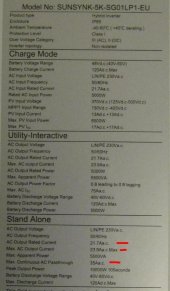Hi,
TL;DR: does the Sunsynk inverter 5000W UPS limit all the time (including when the grid is fine, no outage), or only during grid outage? and would I risk damaging the inverter if I did go over 5000W?
Longer version with more context:
I am having a 5.5kW Sunsynk inverter (and solar panel and battery) being installed at my house at the moment (exiting! ). I will make use of the 'load' port for the UPS function -- the installer will wire that on Monday. To give an idea of my consumption, I peak at 16kWh / day, and the max I have seen on 30min consumption (which is what my smart meter reports) is 2620Wh (but I imagine there may be much higher short peaks hidden in the 30min sampling?).
). I will make use of the 'load' port for the UPS function -- the installer will wire that on Monday. To give an idea of my consumption, I peak at 16kWh / day, and the max I have seen on 30min consumption (which is what my smart meter reports) is 2620Wh (but I imagine there may be much higher short peaks hidden in the 30min sampling?).
However it looks like my fridge/freezer, which I do want UPS for, is on the same socket ring as big consumers in my kitchen and utility rooms: washing machine (mostly used at low temperature, e.g. 30C or 40C), (efficient heat-pump based) tumble dryer, 1000W microwave, kettle. I don't need UPS for them, and I would happily not use them during a grid outage (if only to have longer battery life for the real essentials!). I am not sure what is the peak usage of each of them, but I wonder if all combine may make me go over the 5000W limit of the 'Load' (UPS) port on the inverter.
Any view on that?
Now Looking at this diagram from Sunsynk:

I wonder if the 'Load' is served from the Grid in a normal situation, in which case possibly the 5000W limit only applies when there is a grid outage (in which case I should be fine?): is this the case?
Final question: if the UPS usage did go over 5000W (while the grid is working fine, or during a grid outage), what would happen? would the inverter cap at 5000W or disable itself, causing a power outage on things plugged on it, but without causing damage on the inverter? or in other words, how careful should I be about never going over that 5000W limit?
Thanks!
TL;DR: does the Sunsynk inverter 5000W UPS limit all the time (including when the grid is fine, no outage), or only during grid outage? and would I risk damaging the inverter if I did go over 5000W?
Longer version with more context:
I am having a 5.5kW Sunsynk inverter (and solar panel and battery) being installed at my house at the moment (exiting!
However it looks like my fridge/freezer, which I do want UPS for, is on the same socket ring as big consumers in my kitchen and utility rooms: washing machine (mostly used at low temperature, e.g. 30C or 40C), (efficient heat-pump based) tumble dryer, 1000W microwave, kettle. I don't need UPS for them, and I would happily not use them during a grid outage (if only to have longer battery life for the real essentials!). I am not sure what is the peak usage of each of them, but I wonder if all combine may make me go over the 5000W limit of the 'Load' (UPS) port on the inverter.
Any view on that?
Now Looking at this diagram from Sunsynk:
I wonder if the 'Load' is served from the Grid in a normal situation, in which case possibly the 5000W limit only applies when there is a grid outage (in which case I should be fine?): is this the case?
Final question: if the UPS usage did go over 5000W (while the grid is working fine, or during a grid outage), what would happen? would the inverter cap at 5000W or disable itself, causing a power outage on things plugged on it, but without causing damage on the inverter? or in other words, how careful should I be about never going over that 5000W limit?
Thanks!



